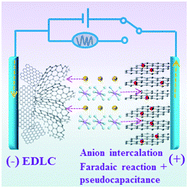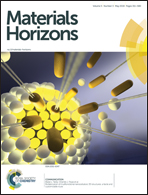Pseudocapacitance contribution in boron-doped graphite sheets for anion storage enables high-performance sodium-ion capacitors†
Abstract
Research on metal-ion hybrid capacitors is emerging as one of the hottest topics in energy storage fields because of their combination of high power and energy densities. To improve the sluggish faradaic reaction in traditional electrode materials for metal-ion hybrid capacitors, intercalation pseudocapacitive materials have been developed as attractive candidates. However, all the previously reported pseudocapacitances in intercalation/deintercalation reactions are based on cations (Li+, Na+, Zn2+etc.). In this work, we demonstrated the high pseudocapacitance contribution in boron-doped graphite (BG) sheets by taking advantage of anion storage. The BG electrode can reversibly store anions (PF6−) through both a surface-controlled pseudocapacitive reaction and a diffusion-limited intercalation/deintercalation reaction. The fabricated Na-ion hybrid capacitor with a BG cathode exhibits superior electrochemical performance. Density functional theory (DFT) calculation reveals that B-doping can significantly reduce the PF6− diffusion energy barrier in the graphite layers.

- This article is part of the themed collections: Materials Horizons 10th anniversary regional spotlight collection: Asia-Pacific, Horizons Community Board Collection – Advanced Energy Storage Technologies, International Year of the Periodic Table: Elements for Next Generation Batteries and Materials Horizons Most Popular Articles


 Please wait while we load your content...
Please wait while we load your content...